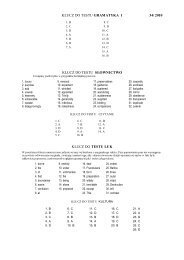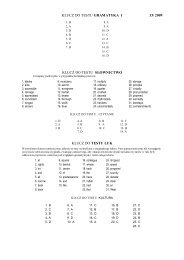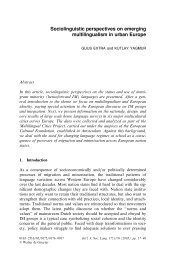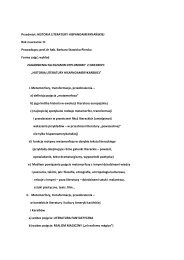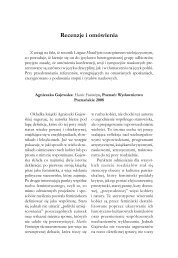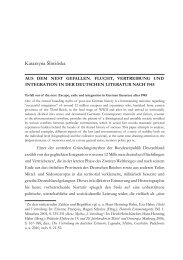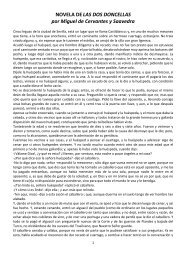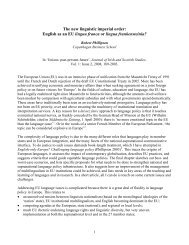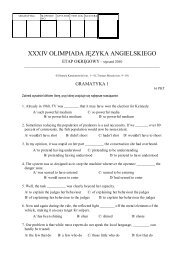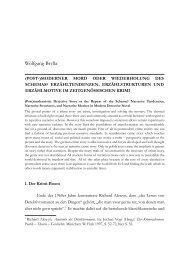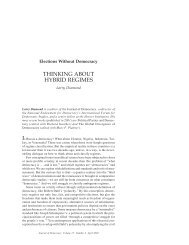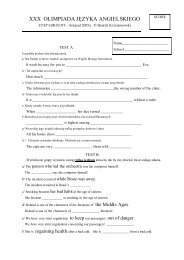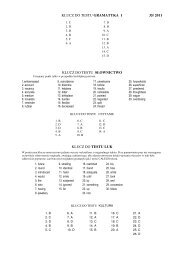African American women and feminism: Alice Walker's womanism ...
African American women and feminism: Alice Walker's womanism ...
African American women and feminism: Alice Walker's womanism ...
Create successful ePaper yourself
Turn your PDF publications into a flip-book with our unique Google optimized e-Paper software.
<strong>African</strong> <strong>American</strong> <strong>women</strong> <strong>and</strong> <strong>feminism</strong>: <strong>Alice</strong> Walker’s <strong>womanism</strong> as a proposition of a dialogic encounter 17<br />
As Related by Himself in 1774. Gates starts his analysis of the trope by quoting the<br />
famous passage of Gronniosaw’s narrative, in which the narrator describes how<br />
he unsuccessfully tried to hear the master’s book talk to him by literally putting<br />
his ear close to it, which brought Gronniosaw to the (only logical for him) conclusion<br />
that everybody <strong>and</strong> everything despised him for his blackness. Gates sees the<br />
book’s refusal to speak to the Black man as the renaming of “the received tradition<br />
in European letters that the mask of blackness worn by Gronniosaw <strong>and</strong> his<br />
countrymen was a trope of absence” 33 . The fact that Gronniosaw could not hear<br />
the book indicates that this “canonical text of Western letters – either the Bible<br />
or the prayer book” – could not see him or hear him, as “texts can only address<br />
that which they can see”, concludes Gates 34 . On the one h<strong>and</strong>, Gronniosaw’s<br />
conflation of vision <strong>and</strong> voice, that is the visual <strong>and</strong> the oral, is paradoxical; on<br />
the other h<strong>and</strong>, it becomes logical in Gronniosaw’s narrative, in which the text’s<br />
voice “presupposed a face; <strong>and</strong> a black face, in turn, presupposed the text’s silence<br />
since blackness was a sign of silence, the remarkably ultimate absence of face <strong>and</strong><br />
voice” 35 . Many years later, Gronniosaw managed to undo the relationship between<br />
silence <strong>and</strong> blackness by writing his autobiography, “a text that speaks his face<br />
into existence among the authors <strong>and</strong> texts of the Western tradition”, thanks to<br />
the fact that he “was fully able to structure the events of his life into a pattern<br />
that speaks quite eloquently, if ironically, to readers today” 36 .<br />
The trope of the Talking Book, as analyzed by Gates, is illustrative of the<br />
tension “between the black vernacular <strong>and</strong> the literate white text, between the<br />
spoken <strong>and</strong> the written word, between the oral <strong>and</strong> the printed forms of literary<br />
discourse”, which has been addressed by Black writers since the eighteenth<br />
century, when slaves attempted to prove their humanity “by literally writing<br />
themselves into being” 37 . Hence, Gates connects the paradoxical trope of “the<br />
oral within the written” as notions of voice/presence <strong>and</strong> silence/absence with<br />
<strong>African</strong> <strong>American</strong> literary tradition 38 . The recourse to the Talking Book trope<br />
demonstrates that Walker, by literally finding “a room of her own” in Woolf ’s<br />
essay, makes this text speak with a Black voice.<br />
Walker is of the opinion that an <strong>African</strong> <strong>American</strong> woman artist has to align<br />
herself with “the living creativity some of our great-gr<strong>and</strong>mothers were not al-<br />
33<br />
H. L. Gates, Jr., The Signifying Monkey: A Theory of <strong>African</strong>-<strong>American</strong> Literary Criticism, op.cit.,<br />
p. 137.<br />
34<br />
Ibid.<br />
35<br />
Ibid.<br />
36<br />
H. L. Gates, Jr., The Signifying Monkey: A Theory of <strong>African</strong>-<strong>American</strong> Literary Criticism, op.cit.,<br />
p. 138, 142.<br />
37<br />
H. L. Gates, Jr., The Signifying Monkey: A Theory of <strong>African</strong>-<strong>American</strong> Literary Criticism, op.cit.,<br />
p. 131.<br />
38<br />
Ibid.



